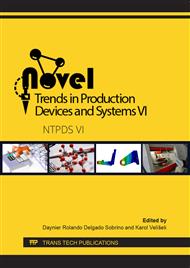p.28
p.36
p.44
p.52
p.62
p.70
p.78
p.88
p.96
Experimental Determination of Mechanical Properties of Waste Steel Sheets
Abstract:
The paper is primarily focused on the determination of the ultimate strength of pressed materials in the form of steel sheets. The breaking strength of homogeneous materials such as e.g. steel sheet is not a relevant indication for pressed steel sheet waste material. The ultimate strength serves as a main parameter in the design of sheet metal cutting machines. For the design and technological design of machines and equipment for shearing steel waste in the form of pressed sheets, it is necessary to know the limit strength of the material. The paper describes in detail the experimental procedure and the principle of determining the ultimate strength of the steel waste sheet. Several dozen experimental samples of pressed metal waste were used. The very principle of the experiment consisted of sheared samples, while monitoring the shear force and the thickness of the pressed material. The ultimate strength of the shear material was calculated from the measured data. The measured and calculated data were statistically processed to increase the objectivity of the determination of the already mentioned ultimate strength parameter of the pressed waste sheets.
Info:
Periodical:
Pages:
62-69
Citation:
Online since:
May 2020
Authors:
Price:
Сopyright:
© 2020 Trans Tech Publications Ltd. All Rights Reserved
Share:
Citation:


